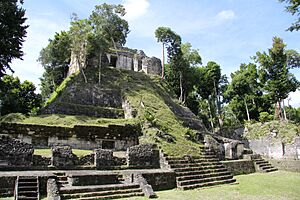Nakum facts for kids
Nakum is an ancient city of the Maya civilization. Its name means "House of the pot." This important archaeological site is found in the Petén region of Guatemala. It was once a major center for ceremonies and city life. Nakum is part of the "Cultural Triangle" along with Yaxha and Naranjo. It sits near the Holmul River. You can see many restored buildings here. The roof comb of its main temple is one of the best preserved outside of Tikal.
Contents
Exploring Nakum's Past
Nakum was first settled during the Middle Preclassic period. For much of the Classic period, it was connected to Tikal. Nakum truly thrived during the Late Classic period (around 700 to 900 AD). This was because of its great location near the Holmul River. The river was an important route for trade and communication.
What We See Today
All the buildings you can see at Nakum today were built during this busy time. There are 15 stone monuments called stelae. Structure A has a special "triadic" top, meaning it has three smaller pyramids on top of a larger one. This structure, along with Structure C, formed an astronomical complex. Structure V has special arched ceilings and tall walls. Nakum also has the most ancient Maya script graffiti found outside of Tikal.
Nakum's Peak and End
Nakum reached its greatest power in the Terminal Classic period. It might have even become an independent city around this time. However, the city was abandoned not long after its peak.
Layout of the Ancient City
The site of Nakum is split into two main parts: the North and South sectors. A pathway called the Perigny causeway connects them.
Northern Sector Buildings
The Northern sector has many impressive buildings. However, archaeologists have not explored this area as much yet.
Southern Sector Structures
The Southern sector is larger. It includes the main Acropolis, which is a raised area with important buildings. There are 11 courtyards and many different types of structures. One building, known as the D building, is a huge "palace" with 44 rooms!
The Main Acropolis
In the middle of the Southern complex is another raised Acropolis. From here, you can see many other important buildings. This Acropolis holds Structure Y. Because of its location, experts believe Structure Y was the main home for Nakum's ruler. The large size of the main Acropolis shows that political power was very important in this city.
Temples and Plazas
The temples in the south of the city are located in the Central Plaza. Temples A, B, and C form a clear triangle pointing north. Like in Tikal, Nakum's Central Plaza faces the four main directions. The city's palace complex is located to the south of this plaza. It's likely that the ruler and royal family watched rituals and performances from Palace D.
Other Plazas
Next is the East Plaza, which holds Temple V. This plaza was abandoned for some reason. Since the temple faces east, it was probably connected to the sun god. Finally, the South East Plaza holds Temple U. This plaza has a direct link to the main Acropolis.
Discovery of Nakum
The site we know as Nakum was rediscovered in 1905 by Maurice de Périgny. He called it "Nacun." Since then, many archaeological teams have worked at the site. This includes an expedition from the Peabody Museum in 1909-1910. Guatemalan authorities started an official restoration project in 1990.
See also
 In Spanish: Nakum para niños
In Spanish: Nakum para niños


